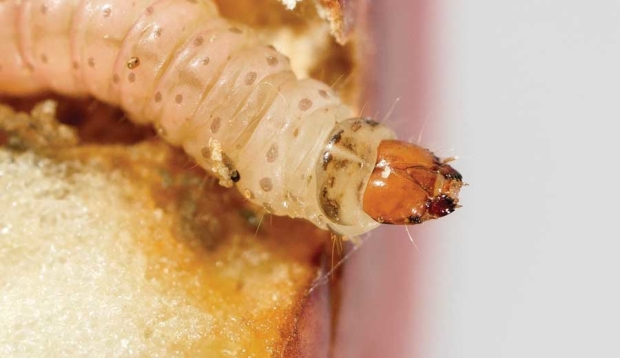
A portrait of a codling moth crawling around on a Gala apple at the Good Fruit Grower magazine on Oct. 1, 2015 in Yakima, Washington. (TJ Mullinax/Good Fruit Grower photo illustration)
Pests posed a challenge to some growers in the record heat of 2015, but the heat presented an opportunity for researchers to learn more about how best to control two of them — codling moth and obliquebanded leafroller — when temperatures are high.
Dr. Vince Jones, entomologist at Washington State University’s Tree Fruit Research and Extension Center in Wenatchee, Washington, compared 2015 temperatures to those of a similar high-temperature year, 1958.
The result: Summer was not hotter, but spring and fall were warmer, creating additional degree-days at key times and enabling an additional generation of both codling moth and leafroller.
“It’s not just the total degree-day accumulation that’s important; it’s when the degree-day accumulation occurs,” Jones told growers at the Washington State Tree Fruit Association Annual Meeting in December.
The hotter year overall means more codling moth generations will occur and higher numbers will emerge in 2016.
The warm fall also means more larvae that escaped diapause (the dormant stage that overwinters) in August would still make it successfully to the overwintering stage, which is true for both codling moth and leafroller.
These factors could make control difficult for growers again, and forecasters are predicting 2016 will be another hot year, Jones said.
Codling moth
For roughly the past 50 years, growers have generally applied two sprays per generation to control codling moth in a year with average temperatures. The first spray occurs at 3 percent to 5 percent egg hatch — or roughly 425 degree-days — followed by a second spray 14 days later.
Following research by WSU entomologist Jay Brunner, some growers began using a delayed first cover approach to target the first and second generations.
The idea is to put oil on just before egg hatch at 375 degree-days, then a second larvicide spray at 525 degree-days and a third spray 14 days later. Organic growers can follow the same method but substitute organic materials.
In 2015, Jones tested those treatments to determine efficacy in a warm year. He found that pesticide treatments alone have roughly the same effectiveness as in a cooler year. “It’s not to say they didn’t work well, but remember, you have another generation to fight,” he said.
However, adding a delayed first cover made the applications twice as effective overall and cut the codling moth population by half.
“Unless you miss that first window, you really should be using this delayed first cover in almost every circumstance,” he said.
Jones also found that all of the codling moth treatments worked better when paired with mating disruption. “Even a weak treatment program is better with mating disruption than a good, conventional plan without it,” he said.
And there’s a bonus: Conventional codling moth treatments can also reduce incidence of obliquebanded leafroller by about 70 percent.
He advised growers to keep a close tab on growing degree-days through the season, because being off by even one day can allow a significant number of larvae to enter the fruit.
Obliquebanded leafroller
Diapause induction is not as well studied for leafroller, but studies suggest there is a critical day length and heat factor crucial to determining the number of generations, Jones said. Some larvae go through five instars, others through six instars.
Jones determined there are four periods during the season that showed significant efficacy for targeting leafroller, and timing is everything. Shoot growth early in the season limits residual effectiveness, and in summer, residues last 30 to 50 days for treated foliage.
—Applying larvicide alone at 90 degree-days is an important step in controlling leafroller.
—Applying an ovicide with oil at 720 degree-days is helpful, but by itself provided the worst control of the four application windows.
—Applying larvicide plus oil at 900 degree-days is the most important step in controlling leafroller, and the one application growers absolutely should not miss.
—Applying larvicide plus oil at 1,800 degree-days can also be helpful, but it is more difficult to get coverage.
Growers can use any three of these four windows to similar efficacy, Jones said, and hitting all four is only marginally better. “Any three window treatments is better than the old standard timing,” he said.
Jones said control recommendations for obliquebanded leafroller will be updated for growers for the 2016 season on WSU’s Decision Aid System (das.wsu.edu) following last year’s research. •
– by Shannon Dininny






Leave A Comment